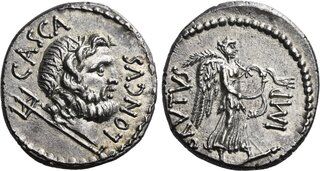| Numismatica Ars Classica > Auction 143 | Auction date: 7 May 2024 |
| Lot number: 414 Price realized: This lot is for sale in an upcoming auction - Bid on this lot  | Show similar lots on CoinArchives Find similar lots in upcoming auctions on |
| Lot description: The Dioscuri Collection. The Roman Republic. M. Junius Brutus and P. Servilius Casca Longus. Denarius, mint moving with Brutus 43-42, AR 19 mm, 3.93 g. CASCA – LONGVS Wreathed head of Neptune r.; below, trident. Rev. BRVTVS – IMP Victory walking r. on broken sceptre and holding palm branch over l. shoulder and broken diadem with both hands. Babelon Junia 44 and Servilia 37. C 3. Sydenham 1298. Sear Imperators 212. RBW 1780. Crawford 507/2. Rare and in exceptional condition for the issue. A superb portrait of fine style well-struck in high relief and lovely old cabinet tone. Good extremely fine Ex NAC 40, 2007, 613 and Gorny & Mosch 181, 2009, 328 sales. Unlike many of his other denarius issues, which pay homage to the deeds of his arch-Republican ancestor, L. Junius Brutus, or to his actions as a leading figure in the assassination of Julius Caesar, this issue of the Liberator M. Junius Brutus seems to look forward to the expected outcome of the imminent Battle of Philippi (3 and 23 October 42 BC). The reverse type dramatically shows Victory trampling on a broken sceptre while she tears a royal diadem in her hands. This representation illustrates the belief (or hope) that the forces of the Liberators would achieve a victory that would destroy the Caesareans and the hated trappings of monarchy promoted by the dead dictator. One wonders whether the diadem and the sceptre might have been intended to represent the two leading figures of the Caesarean faction, Octavian and Mark Antony, broken by the victory of the Liberators and their republican ideals. The obverse names P. Servilius Casca Longus, one of Caesar's assassins and the man appointed to command Brutus' fleet. The associated type depicting the head of Neptune with his trident has sometimes been interpreted as an allusion to Cassius' earlier victory over the Rhodian fleet, but this seems somewhat unlikely considering that Casca was Brutus' man and had no personal involvement in the capture of Rhodes. The type is much more likely to have been intended to advertise Casca's important naval command and the power of Brutus' fleet on the eve of Philippi. Unfortunately for Brutus, while the ships of the Liberators were far more numerous than those of the Caesareans and could dominate the sea, this naval superiority could not help them win the land battle necessary for the Republican cause to triumph. After suffering defeat and retaining only four legions on 23 October 42 BC, Brutus gave up all hope of a future victory like the one depicted on this coin and fell on his own sword. Estimate: 5000 CHF |  |



